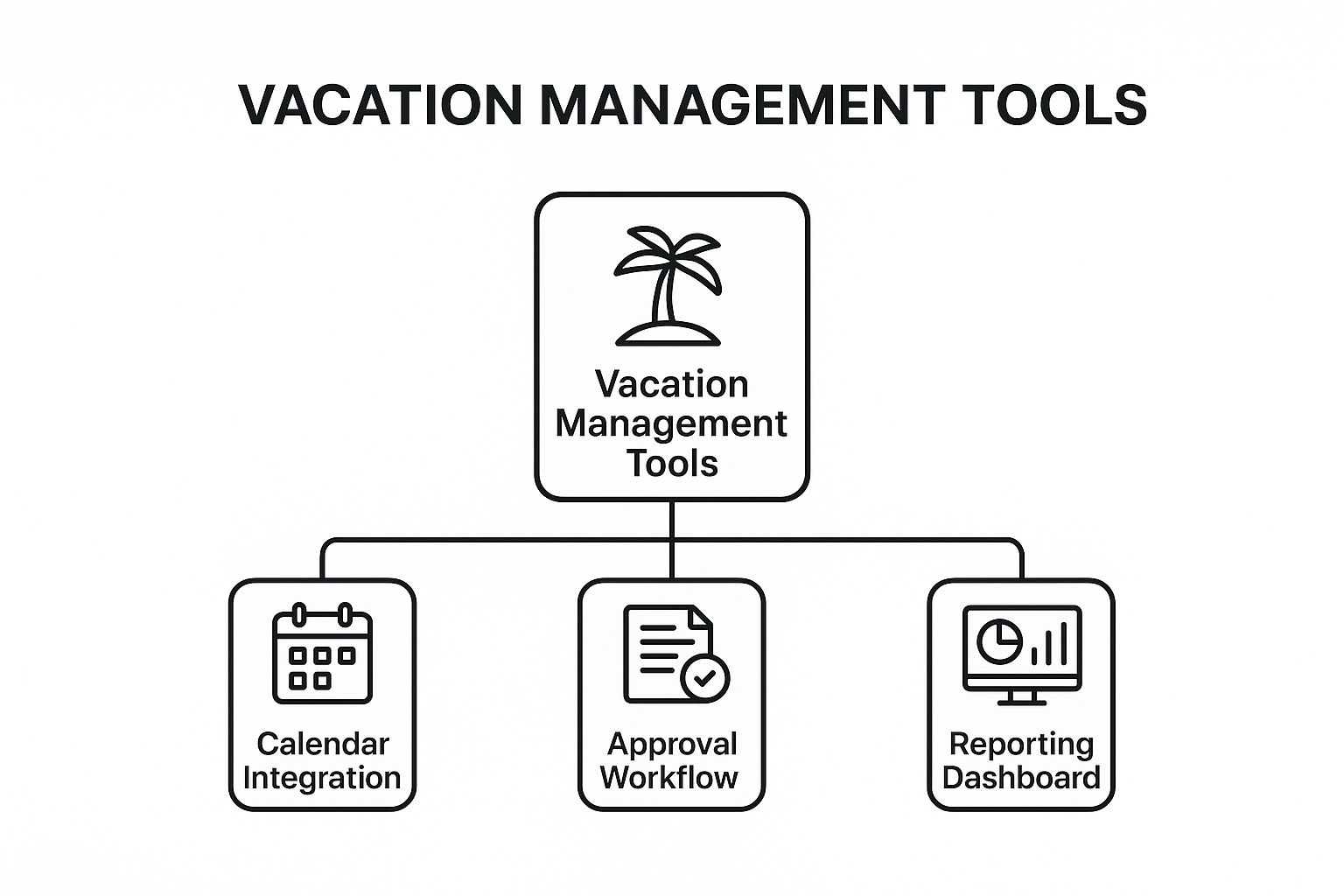Understanding Employee Vacation Calendars: Your Strategic Advantage
Think of your team like a well-oiled machine. Each part plays a crucial role, and if one piece goes missing, the whole thing can grind to a halt. An employee vacation calendar is like the maintenance schedule, making sure everything runs smoothly even when some parts are temporarily out of service. It’s not just a list of absences; it's a powerful tool that helps organizations proactively manage their workforce, prevent disruptions, and keep productivity high. It's about moving from reactive scrambling to planned, predictable operations.
Why a Simple Spreadsheet Isn't Enough
A simple spreadsheet might work for a very small team, but it quickly becomes a nightmare as your organization grows. Imagine trying to juggle vacation requests, project deadlines, and team dependencies across multiple departments with a static spreadsheet. A robust employee vacation calendar, on the other hand, gives you real-time visibility into team capacity. This empowers managers to make smart decisions about resource allocation and keep projects on track. For more tips on managing absences effectively, check out this article on Absence Management Strategies.
The Global Perspective on Vacation Time
Vacation time isn't a one-size-fits-all concept. It varies widely around the world. France, for example, mandates 30 paid vacation days a year, along with a 35-hour workweek. In contrast, the United States doesn't have a legal minimum for paid vacation, though many employees receive paid time off through their employment contracts. Austria leads the way in Europe, offering 25 paid vacation days plus 13 public holidays, for a total of 38 days off annually. These global differences highlight the need for vacation calendars that are tailored to specific regions. For a deeper dive into global vacation trends, take a look at this resource: Average Vacation Days by Country.
To illustrate these differences, the screenshot below provides a visual representation of vacation time around the world.

As the screenshot shows, different countries prioritize vacation time differently, and this has a direct impact on how businesses operate and plan for employee absences. Understanding these cultural nuances is especially important for global organizations. For more guidance on navigating employee absences, you can refer to this helpful guide: Employee Absence Management.
Let's take a closer look at vacation standards across a few countries:
To better understand these variations, let's look at a comparison table showcasing vacation standards across different countries:
Global Vacation Standards Comparison
This table compares mandatory vacation days, public holidays, total days off, and weekly working hours across various countries.
| Country | Mandatory Vacation Days | Public Holidays | Total Days Off | Weekly Hours |
|---|---|---|---|---|
| France | 30 | 11 | 41 | 35 |
| United States | 0 | 10 | 10 | 40 |
| Austria | 25 | 13 | 38 | 40 |
| Germany | 20 | 9 | 29 | 40 |
| Brazil | 30 | 12 | 42 | 44 |
| Japan | 10 | 16 | 26 | 40 |
Note: This table represents average values and may not reflect specific company policies or regional variations.
As you can see, the total number of days off can vary significantly due to differences in both mandatory vacation days and public holidays. This reinforces the importance of considering local regulations and customs when implementing an employee vacation calendar.
From Reactive to Proactive: The Power of Prediction
Employee vacation calendars are becoming increasingly sophisticated. Imagine a system that not only tracks absences but also predicts potential scheduling conflicts. These advanced calendars analyze project timelines, team dependencies, and vacation requests to identify potential resource bottlenecks before they happen. This predictive capability empowers managers to proactively adjust project plans, reassign tasks, or bring in extra support, ensuring smooth project execution even when team members are away. This proactive approach minimizes disruptions, reduces stress, and boosts overall team morale and productivity.
The Real Cost of Vacation Chaos (And Why It Matters)
Imagine a domino effect. One key team member takes an unexpected vacation, a project deadline whooshes by, a client starts tapping their foot impatiently, and suddenly your team is scrambling. This isn't some far-fetched scenario – it’s the everyday reality for many organizations without a solid employee vacation calendar. And the cost of this chaos goes way beyond simply finding someone to cover shifts.
The Hidden Costs of Poor Vacation Management
The immediate impact is obvious: productivity takes a nosedive. Projects stall, communication breaks down, and decisions get stuck in limbo. But the long-term consequences are often lurking beneath the surface. Team morale can plummet as the remaining employees shoulder the burden of extra work. Client relationships can fray due to slow responses and missed deadlines. These hidden costs can seriously dent your bottom line. The image below paints a rather concerning picture of PTO usage in the US.

The data reveals that 46% of US workers don't use all their PTO, and a whopping 68% continue working while on vacation. This speaks volumes about work-life balance and the unspoken pressure employees feel to stay connected, even when they're supposed to be unplugged. Want to delve deeper into these PTO statistics? Check out this resource: Discover more insights on PTO usage. And here's a sobering thought: some companies have even lost major contracts due to poor coverage planning during employee vacations.
The Impact on Employee Well-being
Beyond the financial fallout, vacation chaos takes its toll on employee well-being. The constant expectation of availability, even during time off, can lead to burnout and a significant dip in job satisfaction. Employees who feel guilty about taking their earned vacation time are less likely to truly disconnect and recharge, impacting their performance when they return. This vicious cycle of stress and overwork can ultimately result in higher turnover rates.
Why an Employee Vacation Calendar Is Essential
A well-designed employee vacation calendar is like a preventative measure, shielding your team from the dangers of vacation chaos. It offers a central hub for team availability, allowing managers to foresee potential conflicts and plan proactively. By fostering transparency and better communication, a vacation calendar empowers teams to manage their time more effectively, reducing stress and boosting overall productivity. Investing in a solid system like the Out of Office Assistant app for Jira Cloud isn't just a perk; it's a strategic decision that protects both your business and your employees.
Features That Separate Good Systems From Great Ones
Most vacation tracking systems are just digital versions of paper forms. They collect information, sure, but they don't really solve the core problems of vacation management. The real magic happens when features shift from administrative burden to strategic advantage. Think of it like this: instead of just knowing who is out, a great system helps you understand the impact of that absence – like ripples in a pond. How does it affect team capacity? What about project timelines?
Key Features of an Effective Employee Vacation Calendar
A truly effective employee vacation calendar has a few key ingredients. Real-time visibility is like having a bird's-eye view of team capacity. Managers can see who's available at a glance. Automated conflict detection acts like a traffic controller, preventing double-bookings before they cause a pile-up. Then there's intelligent scheduling. Imagine a conductor orchestrating a symphony. This feature takes into account project deadlines and team dependencies, optimizing resource allocation like a pro.
Advanced features like predictive planning give you a crystal ball, helping you spot potential staffing gaps months in advance. For more on building great team workflows, check out this article on team collaboration best practices. Smart approval workflows adapt to your team's unique structure like a tailored suit, ensuring smooth and efficient vacation request processing. The infographic below visually represents the core components of effective vacation management tools.

This infographic shows the hierarchy of features, highlighting the importance of calendar integration, a streamlined approval workflow, and a comprehensive reporting dashboard. These elements work together to provide a holistic view of team availability and vacation scheduling. For a deeper dive into integrating vacation calendars, see our article on employee leave management software.
Before we delve into emerging capabilities, let's compare basic and advanced vacation calendar features and their impact on your business. The following table highlights the key differences and why investing in a robust system can make all the difference.
Vacation Calendar Features Comparison
Comparison of basic vs advanced vacation calendar features and their business impact
| Feature Category | Basic System | Advanced System | Business Impact |
|---|---|---|---|
| Visibility | Limited to individual requests | Real-time overview of team availability | Improved resource allocation and project planning |
| Scheduling | Manual, prone to conflicts | Automated, considers project deadlines and dependencies | Reduced scheduling conflicts and optimized workload |
| Approvals | Basic workflow, potential for delays | Automated, adaptable workflows | Faster approvals and improved efficiency |
| Reporting | Limited reporting capabilities | Comprehensive dashboards and insights | Data-driven decision-making and improved workforce planning |
This table clearly illustrates the advantages of an advanced system. From improved visibility to data-driven decision-making, the benefits are substantial and contribute to a more efficient and productive work environment.
Emerging Capabilities
Emerging capabilities are taking employee vacation calendars to the next level. AI-powered vacation suggestions act like a personal travel agent, optimizing both individual preferences and business needs. Mobile accessibility is essential for today's on-the-go workforce, allowing employees to manage their time off from anywhere, anytime. Integration capabilities connect your vacation calendar with other essential tools, like project management platforms such as Jira, as illustrated below.

This screenshot showcases Jira. Integrating your employee vacation calendar with Jira creates a seamless flow of information between project timelines and team availability. This is especially helpful for project planning and execution. Managers can factor in planned absences during sprint planning and resource allocation, minimizing potential disruptions. Combining these powerful tools improves project delivery predictability and team productivity.
Building Vacation Policies People Actually Follow
Before implementing any employee vacation calendar system, you need a strong foundation: vacation policies that balance business needs with the realities of your employees' lives. A sophisticated system is useless if your policies themselves create friction. Think of it like having a high-performance race car with flat tires – it's going nowhere fast.
Balancing Business Needs and Employee Well-being
Crafting effective vacation policies is a delicate balancing act. You need enough staff to keep things running smoothly, but also allow employees time off to recharge and avoid burnout. Open communication with HR, team leaders, and employees is crucial here. It's about understanding the natural rhythms of your business and accommodating individual needs without sacrificing overall productivity.
Handling Tricky Situations
Your vacation policies should also address those inevitable tricky situations. Consider blackout periods – times when vacations are restricted due to high workload. Rather than a complete ban, explore flexible options like staggered vacations or rotating coverage schedules. This minimizes disruption while still allowing some flexibility. Similarly, advance notice requirements should be reasonable and consider both planned vacations and unexpected circumstances.
For insights on how to effectively track absences, check out: Our guide on Employee Absence Tracker.
Creative Policy Solutions
Sometimes, the best solutions come from fresh perspectives. A vacation trading system, where team members can swap vacation slots, offers increased individual flexibility while maintaining team coverage. Department-specific guidelines recognize that different departments operate at different paces. For instance, the marketing team might have more flexibility during certain months than the finance team during tax season. Finally, emergency protocols should be in place to gracefully handle unexpected situations, ensuring critical work is covered, even during emergencies.
The screenshot below, from Wikipedia’s article on annual leave, provides a global view of statutory minimum paid vacation days.
This visualization demonstrates the wide variation in legally mandated vacation time around the world. This highlights the need to adapt your vacation policies to local regulations and cultural norms, especially in a global company.
Communication Is Key
How you communicate your vacation policies is as important as the policies themselves. Instead of a list of restrictive rules, present them as a supportive framework for managing time effectively. Highlight the benefits of planned vacations for both the individual and the team. This builds a culture of respect and trust, encouraging responsible use of vacation time and contributing to a more balanced and productive workplace.
Implementation That Actually Works (Lessons From The Trenches)
Rolling out a new employee vacation calendar system can feel like navigating a minefield. It's less about the tech itself and more about shifting how people manage their personal time. A successful rollout hinges on understanding this human element. Think of it like introducing a new family tradition – you need to consider everyone's preferences and existing habits.
Pilot Programs and System Champions
Instead of a company-wide launch, consider starting with a pilot program. Recruit a group of willing volunteers from various teams to test the system and provide feedback. These early adopters become your system champions, organically advocating for the new calendar within their own teams. This grassroots approach builds momentum and softens any resistance to change. Think about how vacation policy changes can impact team morale. Strategies to improve developer experience can offer valuable insights into managing these dynamics. You might also find this resource helpful: Absence Management Strategies.
Training and Change Management
Effective training is more than a one-time presentation. Offer hands-on workshops, create bite-sized video tutorials, and provide ongoing support. Address privacy concerns directly, highlighting data security and access controls. Acknowledge the inevitable "but we've always done it this way" resistance by showcasing the tangible benefits of the new system, like fewer scheduling conflicts and improved planning.
The screenshot below shows the Jira getting started guide, a good example of Jira Cloud's intuitive interface.

This user-friendly design makes adopting new tools like the Out of Office Assistant app for Jira Cloud easier for teams. Integrating vacation management directly into Jira streamlines workflows and reduces the reliance on multiple systems.
Realistic Timelines and Communication
Don't underestimate the implementation timeline. Account for unforeseen delays, technical hiccups, and the learning curve for new users. Communicate regularly throughout the process, keeping everyone updated on progress, addressing any concerns, and building positive anticipation for the new employee vacation calendar. This transparency cultivates trust and makes for a much smoother transition. By focusing on the human side of change, you create a path to successful implementation that benefits both employees and the organization as a whole.
Jira Cloud Vacation Management: A Complete Walkthrough
If your team lives and breathes Jira Cloud, adding another tool for vacation tracking can feel like a wrench in the works. The Out of Office Assistant app neatly solves this by making Jira your central vacation hub, integrating it directly into your existing processes. No more juggling platforms – just smooth sailing and less admin work. Let's explore how teams have successfully incorporated vacation planning into their Jira projects.
Automating Your Workflow With The Out Of Office Assistant
Picture this: a crucial team member requests time off. With the Out of Office Assistant, their Jira issues and approvals are automatically reassigned to colleagues, keeping projects moving forward. This automated handoff prevents tasks from slipping through the cracks. It also frees managers from manually reassigning tasks, giving them more time for strategic work. And sprint planning? Now you can incorporate capacity forecasting based on vacation schedules, setting more realistic sprint goals and avoiding overcommitment.
The screenshot below shows the Out of Office Assistant app overview on the Atlassian Marketplace.
This screenshot highlights features like automated handover, calendar integration, and reporting. These features combine to create a comprehensive vacation management solution within Jira, boosting transparency and workflow efficiency. For example, the calendar syncs with platforms like Outlook and Google Calendar, accurately reflecting vacation time in Jira. Managers can then see team availability across projects directly in Jira, getting a complete picture of resource allocation without needing to check other systems.
Advanced Features For Seamless Integration
Vacation requests can automatically trigger coverage assignments, and team announcements can be integrated with Confluence pages, keeping everyone in the loop. This seamless communication ensures everyone knows about planned absences and who's covering. The app's reporting reveals usage patterns, which can be used to improve future planning and resource allocation. For example, by analyzing past vacation data, managers can anticipate staffing gaps during busy periods and proactively arrange coverage.
Configuration and Customization
Setting up a new tool can be tricky. We'll tackle common setup challenges and offer tips for maximizing the app's potential. The Out of Office Assistant can be tailored to the specific needs of both Agile teams and traditional project structures. This ensures it adapts to your team's unique workflow, whether you're using Scrum, Kanban, or a more traditional approach. This flexibility makes it valuable for a wide range of teams and organizations. By integrating vacation management directly into Jira, teams can streamline their processes, improve communication, and ultimately boost productivity.
Measuring Success and Continuous Improvement
So, you've planted the seed and your employee vacation calendar has sprouted. But how do you know if it's truly flourishing? Real success isn't just about neatly logging vacation requests; it's about nurturing a healthier work environment and seeing tangible growth in your team's well-being and your organization's productivity.
Key Metrics That Matter
Forget superficial metrics like how many times someone logs in. Instead, focus on the real indicators of improvement: fewer last-minute scheduling fire drills, more predictable project timelines, and happier employees who feel more in control of their work-life balance. Most importantly, are your employees actually taking more vacation? Increased vacation utilization is a strong sign of a healthy work environment. If your company utilizes QuickBooks, integrating it with a QuickBooks Cloud Hosting solution can improve access and collaboration, mirroring the advantages of using Jira Cloud for vacation tracking.
Gathering Feedback and Driving Change
Data tells a story, but the most valuable narratives come directly from your team. Regularly gather feedback from both employees and managers. Are there any thorns in the system? Are there features wilting from lack of use? This feedback is invaluable. Use it to prune your policies, fertilize your system, and cultivate a vacation calendar that continuously adapts to your team's needs. For further insights, consider this article on reassigning Jira issues for vacation tracking.
Continuous Improvement: The Long Game
Like any thriving garden, your employee vacation calendar needs ongoing care. Establish a regular review cycle, perhaps quarterly. Set benchmarks that resonate with your organization's goals. How does your vacation utilization compare to industry averages? Are there recurring weeds of conflict you can address proactively? By consistently measuring, analyzing, and adapting, you'll ensure your vacation management system isn't just another tool gathering dust, but a vital part of a flourishing and productive workplace. This continuous evolution transforms your calendar from a simple tracking system into a powerful strategic asset.
Ready to cultivate a thriving vacation management system for your team? Explore the benefits of the Out of Office Assistant for Jira Cloud. Improve your workflows, empower your team, and cultivate a more balanced and productive work environment. Visit Resolution's Out of Office Assistant today!
